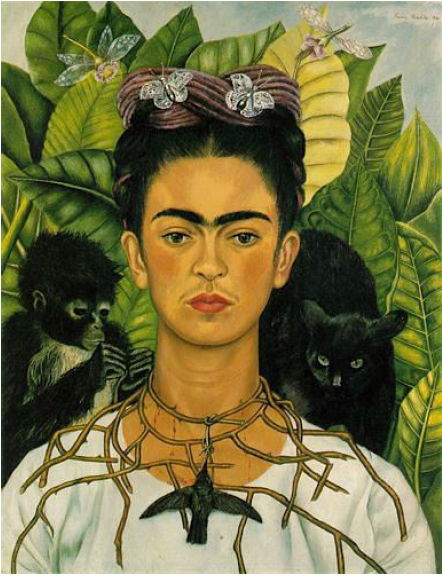She has been described as “a tequila-slamming, dirty joke-telling smoker, bi-sexual that hobbled about her bohemian barrio in lavish indigenous dress and threw festive dinner parties“. Way ahead of her time, Frida Kahlo is one of the most pulsating women in world history. The attempt of a portrait that does justice to this grand diva.

Frida Kahlo comes into the world as Magdalena Carmen Frieda Kahlo Calderón on July 6 in 1907. Later she doesn’t only change her name but also her year of birth – to 1910, the year of the Mexican Revolution in order to highlight that her actual life started with the modern Mexico. Frida’s father is a German photographer from Pforzheim, her mother a very traditional and religious Mexican woman. The family lives in Coyoacán, a city that is part of Mexico-City today. Already during her early years young Frida has to face two calamities: On the one hand, she falls ill with polio at the age of six. The disease leads to differently long legs which made her limping a lifetime. On the other hand, she gets seriously injured during a traffic accident in 1925. For convalescing she has to stay in bed in a full body cast for three months; as a pastime and in order to come to terms, the 18-year-old girl starts painting. Frida’s pain and passion are central in her vibrant, colorful works which are consciously naive and symbolic. Some people say that hardly anybody’s oeuvre is as close connected with an artist’s biography as the one of Frida. Frequently she paints herself “because I am so often alone and because I am the subject I know best“. In doing so, she especially highlights her monobrow and facial hair.
At the age of 22, Frida marries Diego Rivera, a famous Mexican muralist who admires her paintings and is, as she herself, an active communist. The relationship is overshadowed by Diego’s unfaithfulness but Frida is also no child of sorrow: she has numerous flings as well – with males and females. When Diego, however, sleeps with Frida’s younger sister Christina in 1934, the couple moves into separated houses which are connected with a little bridge. In 1939, they get divorced, but marry again only one year later. “I suffered two grave accidents in my life“, Frida once says, “One in which a streetcar knocked me down and the other was Diego.“ She tries to drown the disappointments of her love live in alcohol as well as her health problems. Because of the traffic accident during her adolescence, she has to bear more than 30 operations and wear various corsets time and again. On top of this, she isn’t able to have children. “I drank to drown my sorrows, but the dammed things learned how to swim“, she once says. The only thing that really helps is painting and Frida gets more and more successful: exhibitions of her works in the United States and France are well received by the public. In 1939, the Louvre purchases one of her self-portraits – a little sensation as this honor hasn’t been granted to a Mexican artist before. Her greatest wish, however, gets true 14 years later, when she gets her first solo-exhibition in her mother country. By this point, Frida’s stage of health is already as worse that her doctor makes her promise to not exit the bed. Therefore, she let carry herself to the opening in her bed.
During her lifetime, her husband Diego is always more successful than Frida. She is only rediscovered in the course of the feminist movement of the seventies, when she is celebrated as an icon. Frida passes away on July 13, 1954, at the age of 47. Officially, her cause of death is lung embolism. Diego, however, doesn’t permit an autopsy; hence, some friends regard suicide as more likely. Her last diary entry reads: “I hope the exist is joyful and I hope never to return“. R.I.P. Frida.